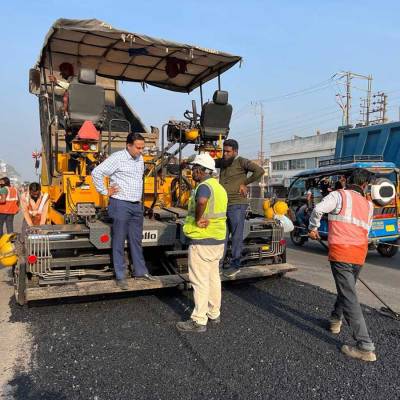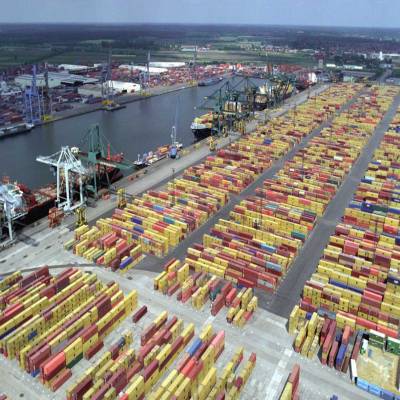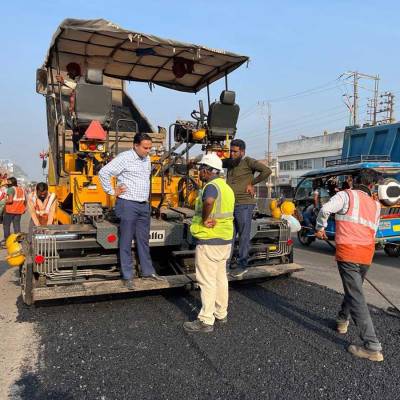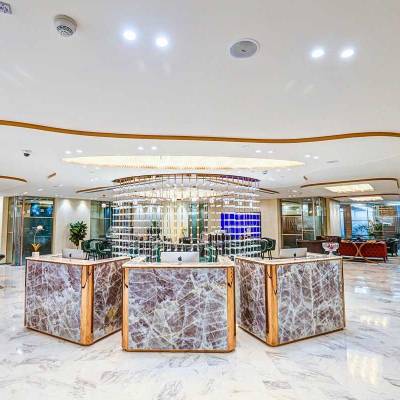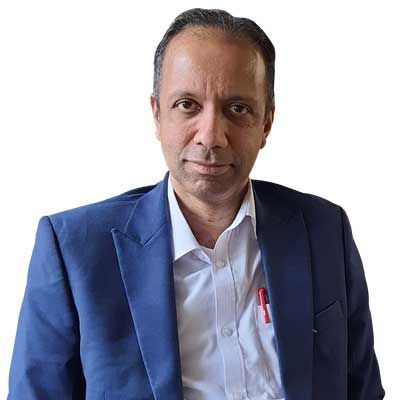- Home
- Infrastructure Transport
- ROADS & HIGHWAYS
- Bouquets, Brickbats and a Wishlist

Bouquets, Brickbats and a Wishlist
2016 promises to be remembered as the year of demonetisation. Certainly, the initiative has slowed project execution and the growth momentum. Contractors have been busy, making arrangements on site to open bank accounts for workers and switching to online payments for petty supplies. Want of upfront cash has also slowed down the movement of goods.
But it´s not all bad. In the long run, real-estate companies expect demonetisation (and the Real Estate Act) to help move to full cheque payments and greater transparency; this, in turn, may attract institutional capital and boost international investor confidence in India.he Indian real estate sector has historically bee As we usher in 2017, let´s also not forget the government initiatives prior to demonetisation that set a brisk pace of development across key sectors. So, here is a look at the crests and the troughs of 2016, with some solid suggestions to turn the lows into highs.
ROADS & HIGHWAYS

The year 2016 saw a switch in the modus operandi.
´In FY2016, almost 72 per cent of projects were awarded on the engineering, procurement and construction (EPC) route, which helped revive road construction,´ says Santosh Rai, Head-Transport Sales, HCC. ´In FY2017, the focus has shifted to the hybrid annuity model (HAM) and build-operate-transfer (BOT) toll-based contracts with only about 33 per cent of the total annual target expected to be awarded on the EPC route.´
´2016 has seen a fair number of awards of highway projects on the hybrid model; we bagged one such project,´ shares Vinod Agarwal, Managing Director, GR Infra Projects. ´Competition in the EPC project segment has gotten stronger.´
Major policy announcements included ´An NHAI plan to build 50,000 km of road worth Rs 17 lakh crore over the next five to six years and MoRTH´s plans to construct 7,000 km of national highway worth Rs 80,000 crore under the Bharatmala Paryojana Scheme,´ says Rai. ´Other positive initiatives were upfront land acquisition, expediting MoEF approvals and awarding projects only after the availability of 80 per cent ROW.´
Recommendations by Vinod Agarwal
cw-b.png)
- With about 75 per cent of hybrid project awardees still struggling because of low lender confidence in the sector, it would be helpful for the ministry to meet with lenders to clear their concerns about project conditions covering the timing and amount of termination payments. If need be, amend the model to ensure the lender´s comfort levels.
- Take action against contractors who compromise on quality by cutting costs to unrealistic levels.
- While it is good to see more players in the EPC segment, cutthroat competition has led to unrealistic bidding, which in turn affects quality.
Recommendations by Santosh Rai
cw-b.png)
- With most road players still struggling with stretched balance sheets, an increased thrust on the EPC mode would be helpful.
- Include a mechanism for sharing risks arising on account of geological surprises in the EPC tenders of tunnelling projects in the Himalayan geology.
- Cost and schedule appraisals of road projects in hilly terrains like the Northeast should be done on a case-to-case basis using detailed investigation.
SMART CITIES

The year 2016 saw the Smart City mission kick off with successive announcements naming 60 target cities. Some of these have been quick to get off the mark. ´Several target smart cities have already identified the SPV leader and consultant and some have even received an initial tranche of funds from the Central Government,´ says R Srinivasan, Vice President & Head, Smart World & Communication, L&T Construction.
All this is bringing huge collaborative opportunities for cutting-edge technologies and services in core infrastructure services. ´With some cities having started tendering out packages for smart security, smart communication and telecommunications and smart infrastructure solutions, L&T´s Smart World business unit, which has emerged as one of the fastest growing within the L&T portfolio, is well positioned in this sector,´ adds Srinivasan.
´With a strong and equal play of operational technology and information technology in smart cities, our focus areas will be IT, data centres, connectivity, intelligent building management systems and data centre infrastructure management solutions,´ says Kanwaljeet Kukreja, Business Development, Energy & Smart Cities, Schneider Electric, India. ´Energy optimisation, analytics and citizen service improvement are also on our radar.´
Things promise to get better. ´We expect the tally to increase to 100 in the next few years,´ says Kukreja. And Digital India is making progress too. ´We´re seeing a push for the creation of a digital backbone connecting all the panchayats, with execution having begun on the leftover panchayats of the earlier scheme,´ says Srinivasan.
Recommendations by R Srinivasan
cw-b.png)
- Like Nagpur, all selected cities should quickly implement their pilot projects with smart elements and pan-city initiative.
- Provide single-window clearance for approvals with single-point responsibility for implementation of projects across utilities.
- Make finance available through grants, floating municipal bonds, multilateral funding, etc.
- For adequate handholding, choose a strong ´master systems integrator´ for execution from the conceptual stage.
- Get states to aggressively pursue the Bharat Net Mission to connect all the gram panchayats for e-learning, e-governance, e-health, etc.
Recommendations by Kanwaljeet Kukreja
cw-b.png)
Follow clarity of vision and execution strategy by collaborative implementation by all stakeholders so that the government can swiftly incorporate the lessons that are bound to arise as a result of our economic and socio-cultural diversity in the future strategy.
RAILWAYS

The rail sector is on the right track. The consensus is that it is flush with funds for development, resulting in a project bonanza and prompt payments to contractors. ´We saw zonal railways and their PSUs invite lots of tenders this year - more than in previous years - for new infrastructure projects like doublings, new lines, private sidings, etc,´says Kulmeet Singh Chhabra, Director, Projects, ISC Projects. ´Plenty of tenders are being floated for the replacement of old wooden sleepers with concrete sleepers, much-needed upgrade for safety, lower long-term maintenance costs and creation of employment opportunities,´ says Ashok Mehta, Chairman and Managing Director, Metcon India Realty & Infrastructure. To enhance efficiency and transparency,´Many of these tenders were offered via a new online tender system,´ adds Chhabra.
Plenty of decisions taken in 2016 bode well for experienced, high-performing contractors.´The Indian Government has decided to pay landholders four times the market price to speed up land acquisition,´ says Mehta. ´Projects to connect the West, the Northeast, the North and South, to promote development in remote regions, and rail line modernisation projects in Maharashtra, Gujarat, Andhra Pradesh, Madhya Pradesh, Uttar Pradesh, Bihar, etc, are coming up. A dream freight corridor project is happening. Introducing bullet trains in future will help reduce the pressure on road traffic and ease out aviation traffic.´
Recommendations by Ashok Mehta
cw-b.png)
Deploy young qualified managerial talent, in addition to bureaucrats and conventional engineers, to share the load of engineering teams, ensure time-bound project execution, innovative approaches, better management of land acquisition, and the faster resolution of local problems and issues between departments and contractors.
Make provisions for banks to lend vigorously to the infrastructure sector, to both agencies and contractors. In particular, speed up the issue of bank guarantees, funds to contractors with a proven track record but not only on the basis of their balance sheet.
Recommendations by Kulmeet Singh Chhabra
cw-b.png)
- Finalise tenders faster, say in two to three months, after their initial opening; ensure both government and private land has been acquired before finalisation.
- Improve the prequalification criteria to allow only experienced and financially sound members to form JVs to bid for tenders.
- In view of shortage of staff with the Railways, appoint project management consultancy companies to improve supervision of fieldwork.
REAL ESTATE

Let´s unwind to 2015, when the off-take of commercial real estate grew, on businesses consolidating and expanding work spaces, says Niranjan Hiranandani, Chairman & Managing Director, Hiranandani Group. The Hiranandani group, in particular, clocked the biggest commercial sale: IT giant Tata Consultancy Services acquired 2 million sq ft at Hiranandani Estate, Thane, to house 27,000 employees at full operational value. Market movements in 2015 also created demand for residential real estate in 2016.
What else contributed to better home sentiment this year? Ramesh Ranganathan, Business Head-West and North, Mahindra Lifespaces, lists flattish property prices in recent years, improved affordability, lower interest rates, the RBI repo cut, an optimistic economic outlook, the Real Estate Regulation Act and the implementation of the 7th Pay Commission recommendations. ´Our projects in Mumbai, Pune, Hyderabad, Chennai and Nagpur performed well,´ he adds. ´Markets have been increasingly end-user driven with reputed developers and the right-priced projects in good locations seeing better closure rates.´
Recommendations by Niranjan Hiranandani
cw-b.png)
Ensure proper and time-bound implementation of initiatives such as Smart Cities, Housing for All by 2022, Real Estate Regulation Act and Goods & Services Tax, to usher in transparency and accountability and allow the real-estate industry to play its role as ´builders of the nation´.
Recommendations by Ramesh Ranganathan
cw-b.png)
Focus on urban infrastructure projects.
PORTS

The year 2016 started on a good note with the Maritime Summit and the Sagar Mala port modernisation initiative, says Rajiv Agarwal, CEO & Managing Director, Essar Ports. But he also notes that private-sector participation in projects has been limited compared to 2015 on account of a fund crunch and limited access to low-cost finance. Further, cargo growth this year has been subdued -´Major ports have seen only 6 per cent growth in quarters one and two, primarily on account of external factors and slowdown in the commodity cycle.´
Concerns also exist over the BOT port projects model. The failure of the BOT model in the highway sector has led to the development of a cross between the BOT and annuity schemes to attract investors. While this has found favour in some quarters, it is too soon to call the new model successful, notes Dr PV Chandramohan, President (Technical), Navayuga Engineering Company.
Recommendations by Dr PV Chandramohan
cw-b.png)
Some innovation is needed in port projects; currently, all of them are on a BOT basis. Land acquisition, the government´s investment, takes too long, which makes it challenging for private investors to plan and schedule, which, in turn, causes time and cost overruns and adversely affects cash flow and the project´s financial viability. A port´s layout - which depends on the shape and size of land û affects operational efficiency and its profitability.
For the best outcomes, locate port infrastructure on reclaimed land with suitable soil. Then, there will be no land shortage and no hurdles to a good layout. This is widely done in developed countries.
When choosing a port site, factor in wave climate and morphological factors as well as the origin, destination and availability of cargo. We see political considerations distort these factors.
Recommendations by Rajiv Agarwal
cw-b.png)
- To boost investor confidence, provide access to low-cost, long-term financing for the sector, equitably share risks, take up modernisation projects and expedite the decision-making process. In particular, empower the major ports to revise contractual terms for various concessions to facilitate PPP growth in the sector.
- Remove tariff restrictions; let market forces determine tariffs.
- Offer tax exemptions on LNG imports and on the import of LNG import terminals technology.
- Encourage manufacturing and port-based industries through reliefs for coastal shipping, inland waterways and the utilisation of captive jetties with obligation to service other customers.
- Expedite approvals and land acquisition for projects.
AIRPORTS

First, the good news. ´The year 2016 saw the new civil aviation policy, the launch of the new greenfield international airport project at Bhogapuram (Andhra Pradesh) and the upgradation of Nagpur´s existing international airport, both on DBFOT format, and two more new airports in Andhra Pradesh and one in Telangana being recommended for site clearance,´ says Yogesh Kumar Jain, Managing Director, PNC Infratech.
What was not good? ´The year did not produce as many tangible opportunities as we had hoped for,´ says Guy Perry, President, Cities + Strategy, Essel Infra & Utilities. But hope floats.
´We will see an increasing number of opportunities in 2017,´ adds Perry. ´India is the fastest growing aviation market today and promises to continue to be in the foreseeable future. The Smart City initiative has provided a new level of analytical sophistication that will increasingly affect airports and their surroundings.´
Recommendations by Guy Perry
cw-b.png)
- Rethink airports as hubs to urban development in a pragmatic way. Look at passenger convenience and allow for mixed-use development around airports and safety within airport areas. Airports and cities should increasingly become indistinguishable. At present, many government regulations would prohibit many of the most successful aerocity-type initiatives in other parts of the world, notably through the over-limitation of uses.
Recommendations by Yogesh Kumar Jain
cw-b.png)
- Focus intensely on the aviation sector, akin to roads and highways, by way of increased budgetary allocations and allowing the Airports Authority of India to float bonds in the market, like the National Highway Authority of India, to raise funds for the expeditious development of existing airport infrastructure, including extension or strengthening of airfield pavements, provision of night landing facilities, modernisation of air traffic control and communication facilities, expansion or modernisation of terminal buildings and augmentation of other ancillary facilities on EPC mode.
- Take up only viable and bankable projects on the PPP model, with the balanced sharing of risks and rewards between the authorities and private partners.
POWER
cw.jpg)
The power sector stepped into 2016 with multiple challenges, a recessionary trend and huge amounts locked up in ongoing disputes and/or arbitration awards challenged in various courts by PSUs and central departments.
Given this, ´the Niti Aaayog directives to PSUs and departments to pay up 75 per cent of challenged arbitration awards came as a big boost,´ says Sunil Sapre, Vice President, Patel Engineering. ´To be released against bank guarantees, these payments would help infra contractors reduce their debt, make available some working capital to complete languishing ongoing projects and enable them to aggressively bid for new projects.´
Positives that will help generate positive sentiment and reverse recession, respectively, are the announcement of the New Arbitration Act/Insolvency Code, and the government´s UDAY scheme, an effort towards improving the financial and operational efficiency of ailing DISCOMS, to make more power available and increase demand for electricity, says CK Thakur, President and CEO, Power and Buildings & Infrastructure, Punj Lloyd, and Member, CII National Committee of Power. Thakur also gives the thumbs up to the major shift towards renewable energy with a target of generating 160,000 MW by 2022. ôMajor opportunities in transmission include the Green Energy Transmission Corridor, a long-distance transmission project to make an effective national grid, and augmentation of distribution networks,´ he adds.
Recommendations by CK Thakur
cw-b.png)
- We at CII, have recommended a net marketing scheme, implementation of Goods & Services Tax in the power sector, and looking at enhancing the effectiveness of the UDAY scheme, carriage and content issues, renewable power sustainability issues, etc.
Recommendations by Sunil Sapre
cw-b.png)
Greater spending on the initial geological investigation would augur well for the hydro sector. More detailed investigation would reduce surprises during execution. Variations owing to unpredictable geology in far-flung locations are one of the main reasons for the high gestation period of hydro power projects.
We also need better transparency in contract drafting. Current contracts are heavily tilted in favour of government corporations. Introducing FIDIC contracts has improved the situation somewhat but not fully, as even these are modified in favour of clients by inserting a separate section titled ´Conditions of Particular Application´.
- Charu Bahri
To share your recommendations, write in at feedback@ConstructionWorld.in
- CW
- Concrete
- Real Estate Act
- Santosh Rai
- HCC
- Vinod Agarwal
- GR Infra Projects
- NHAI
- Bharatmala Paryojana Scheme
- Vinod Agarwal
- EPC project
- MoRTH
- Hybrid
- SMART CITIES project
- Smart City Mission
- SPV leader
- R Srinivasan
- L AND T
- Kanwaljeet Kukreja
- Construction
- Schneider Electric
- Kanwaljeet Kukreja
- Kulmeet Singh Chhabra
- ISC Projects
- Metcon India Realty & Infrastructure
- Ashok Mehta
- JVs
- Niranjan Hiranandani
- Hiranandani Group
- Ramesh Ranganathan
- Mahindra Lifespaces
- Rajiv Agarwal
- Essar Ports
- Dr PV Chandramohan
- Navayuga Engineering Company
- PPP growth
- Yogesh Kumar Jain
- PNC Infratech
- Guy Perry
- POWER
- Niti Aaayog
- PSU
- Sunil Sapre
- UDAY scheme
- CK Thakur
- CII National Committee of Power
- FIDIC
CW examines the crests and troughs of 2016, and offers concrete suggestions to turn the lows into highs in 2017. 2016 promises to be remembered as the year of demonetisation. Certainly, the initiative has slowed project execution and the growth momentum. Contractors have been busy, making arrangements on site to open bank accounts for workers and switching to online payments for petty supplies. Want of upfront cash has also slowed down the movement of goods. But it´s not all bad. In the long run, real-estate companies expect demonetisation (and the Real Estate Act) to help move to full cheque payments and greater transparency; this, in turn, may attract institutional capital and boost international investor confidence in India.he Indian real estate sector has historically bee As we usher in 2017, let´s also not forget the government initiatives prior to demonetisation that set a brisk pace of development across key sectors. So, here is a look at the crests and the troughs of 2016, with some solid suggestions to turn the lows into highs. ROADS & HIGHWAYS The year 2016 saw a switch in the modus operandi. ´In FY2016, almost 72 per cent of projects were awarded on the engineering, procurement and construction (EPC) route, which helped revive road construction,´ says Santosh Rai, Head-Transport Sales, HCC. ´In FY2017, the focus has shifted to the hybrid annuity model (HAM) and build-operate-transfer (BOT) toll-based contracts with only about 33 per cent of the total annual target expected to be awarded on the EPC route.´ ´2016 has seen a fair number of awards of highway projects on the hybrid model; we bagged one such project,´ shares Vinod Agarwal, Managing Director, GR Infra Projects. ´Competition in the EPC project segment has gotten stronger.´ Major policy announcements included ´An NHAI plan to build 50,000 km of road worth Rs 17 lakh crore over the next five to six years and MoRTH´s plans to construct 7,000 km of national highway worth Rs 80,000 crore under the Bharatmala Paryojana Scheme,´ says Rai. ´Other positive initiatives were upfront land acquisition, expediting MoEF approvals and awarding projects only after the availability of 80 per cent ROW.´ Recommendations by Vinod Agarwal With about 75 per cent of hybrid project awardees still struggling because of low lender confidence in the sector, it would be helpful for the ministry to meet with lenders to clear their concerns about project conditions covering the timing and amount of termination payments. If need be, amend the model to ensure the lender´s comfort levels. Take action against contractors who compromise on quality by cutting costs to unrealistic levels. While it is good to see more players in the EPC segment, cutthroat competition has led to unrealistic bidding, which in turn affects quality. Recommendations by Santosh Rai With most road players still struggling with stretched balance sheets, an increased thrust on the EPC mode would be helpful. Include a mechanism for sharing risks arising on account of geological surprises in the EPC tenders of tunnelling projects in the Himalayan geology. Cost and schedule appraisals of road projects in hilly terrains like the Northeast should be done on a case-to-case basis using detailed investigation. SMART CITIES The year 2016 saw the Smart City mission kick off with successive announcements naming 60 target cities. Some of these have been quick to get off the mark. ´Several target smart cities have already identified the SPV leader and consultant and some have even received an initial tranche of funds from the Central Government,´ says R Srinivasan, Vice President & Head, Smart World & Communication, L&T Construction. All this is bringing huge collaborative opportunities for cutting-edge technologies and services in core infrastructure services. ´With some cities having started tendering out packages for smart security, smart communication and telecommunications and smart infrastructure solutions, L&T´s Smart World business unit, which has emerged as one of the fastest growing within the L&T portfolio, is well positioned in this sector,´ adds Srinivasan. ´With a strong and equal play of operational technology and information technology in smart cities, our focus areas will be IT, data centres, connectivity, intelligent building management systems and data centre infrastructure management solutions,´ says Kanwaljeet Kukreja, Business Development, Energy & Smart Cities, Schneider Electric, India. ´Energy optimisation, analytics and citizen service improvement are also on our radar.´ Things promise to get better. ´We expect the tally to increase to 100 in the next few years,´ says Kukreja. And Digital India is making progress too. ´We´re seeing a push for the creation of a digital backbone connecting all the panchayats, with execution having begun on the leftover panchayats of the earlier scheme,´ says Srinivasan. Recommendations by R Srinivasan Like Nagpur, all selected cities should quickly implement their pilot projects with smart elements and pan-city initiative. Provide single-window clearance for approvals with single-point responsibility for implementation of projects across utilities. Make finance available through grants, floating municipal bonds, multilateral funding, etc. For adequate handholding, choose a strong ´master systems integrator´ for execution from the conceptual stage. Get states to aggressively pursue the Bharat Net Mission to connect all the gram panchayats for e-learning, e-governance, e-health, etc. Recommendations by Kanwaljeet Kukreja Follow clarity of vision and execution strategy by collaborative implementation by all stakeholders so that the government can swiftly incorporate the lessons that are bound to arise as a result of our economic and socio-cultural diversity in the future strategy. RAILWAYS The rail sector is on the right track. The consensus is that it is flush with funds for development, resulting in a project bonanza and prompt payments to contractors. ´We saw zonal railways and their PSUs invite lots of tenders this year - more than in previous years - for new infrastructure projects like doublings, new lines, private sidings, etc,´says Kulmeet Singh Chhabra, Director, Projects, ISC Projects. ´Plenty of tenders are being floated for the replacement of old wooden sleepers with concrete sleepers, much-needed upgrade for safety, lower long-term maintenance costs and creation of employment opportunities,´ says Ashok Mehta, Chairman and Managing Director, Metcon India Realty & Infrastructure. To enhance efficiency and transparency,´Many of these tenders were offered via a new online tender system,´ adds Chhabra. Plenty of decisions taken in 2016 bode well for experienced, high-performing contractors.´The Indian Government has decided to pay landholders four times the market price to speed up land acquisition,´ says Mehta. ´Projects to connect the West, the Northeast, the North and South, to promote development in remote regions, and rail line modernisation projects in Maharashtra, Gujarat, Andhra Pradesh, Madhya Pradesh, Uttar Pradesh, Bihar, etc, are coming up. A dream freight corridor project is happening. Introducing bullet trains in future will help reduce the pressure on road traffic and ease out aviation traffic.´ Recommendations by Ashok Mehta Deploy young qualified managerial talent, in addition to bureaucrats and conventional engineers, to share the load of engineering teams, ensure time-bound project execution, innovative approaches, better management of land acquisition, and the faster resolution of local problems and issues between departments and contractors. Make provisions for banks to lend vigorously to the infrastructure sector, to both agencies and contractors. In particular, speed up the issue of bank guarantees, funds to contractors with a proven track record but not only on the basis of their balance sheet. Recommendations by Kulmeet Singh Chhabra Finalise tenders faster, say in two to three months, after their initial opening; ensure both government and private land has been acquired before finalisation. Improve the prequalification criteria to allow only experienced and financially sound members to form JVs to bid for tenders. In view of shortage of staff with the Railways, appoint project management consultancy companies to improve supervision of fieldwork. REAL ESTATE Let´s unwind to 2015, when the off-take of commercial real estate grew, on businesses consolidating and expanding work spaces, says Niranjan Hiranandani, Chairman & Managing Director, Hiranandani Group. The Hiranandani group, in particular, clocked the biggest commercial sale: IT giant Tata Consultancy Services acquired 2 million sq ft at Hiranandani Estate, Thane, to house 27,000 employees at full operational value. Market movements in 2015 also created demand for residential real estate in 2016. What else contributed to better home sentiment this year? Ramesh Ranganathan, Business Head-West and North, Mahindra Lifespaces, lists flattish property prices in recent years, improved affordability, lower interest rates, the RBI repo cut, an optimistic economic outlook, the Real Estate Regulation Act and the implementation of the 7th Pay Commission recommendations. ´Our projects in Mumbai, Pune, Hyderabad, Chennai and Nagpur performed well,´ he adds. ´Markets have been increasingly end-user driven with reputed developers and the right-priced projects in good locations seeing better closure rates.´ Recommendations by Niranjan Hiranandani Ensure proper and time-bound implementation of initiatives such as Smart Cities, Housing for All by 2022, Real Estate Regulation Act and Goods & Services Tax, to usher in transparency and accountability and allow the real-estate industry to play its role as ´builders of the nation´. Recommendations by Ramesh Ranganathan



